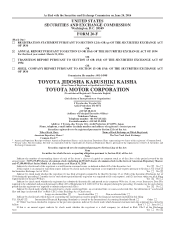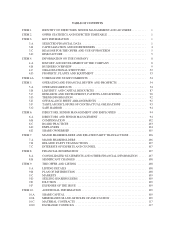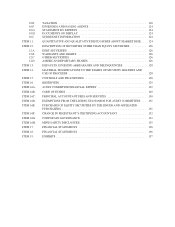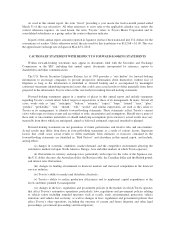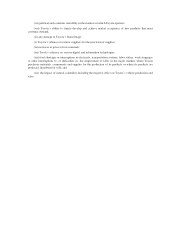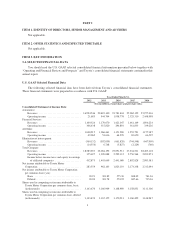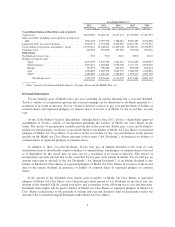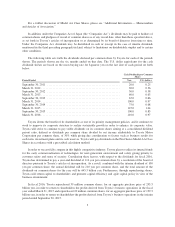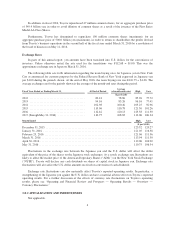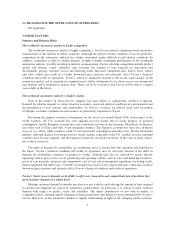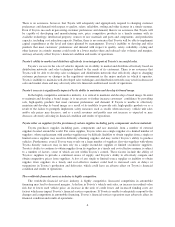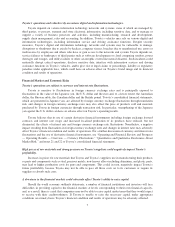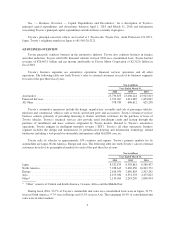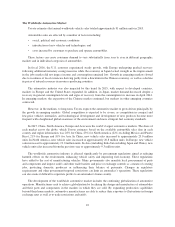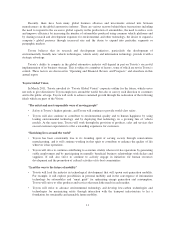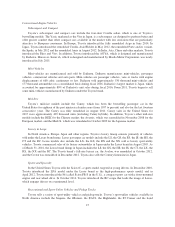Toyota 2015 Annual Report Download - page 10
Download and view the complete annual report
Please find page 10 of the 2015 Toyota annual report below. You can navigate through the pages in the report by either clicking on the pages listed below, or by using the keyword search tool below to find specific information within the annual report.3.C REASONS FOR THE OFFER AND USE OF PROCEEDS
Not applicable.
3.D RISK FACTORS
Industry and Business Risks
The worldwide automotive market is highly competitive.
The worldwide automotive market is highly competitive. Toyota faces intense competition from automotive
manufacturers in the markets in which it operates. Although the global economy continues to recover gradually,
competition in the automotive industry has further intensified amidst difficult overall market conditions. In
addition, competition is likely to further intensify in light of further continuing globalization in the worldwide
automotive industry, possibly resulting in industry reorganizations. Factors affecting competition include product
quality and features, safety, reliability, fuel economy, the amount of time required for innovation and
development, pricing, customer service and financing terms. Increased competition may lead to lower vehicle
unit sales, which may result in a further downward price pressure and adversely affect Toyota’s financial
condition and results of operations. Toyota’s ability to adequately respond to the recent rapid changes in the
automotive market and to maintain its competitiveness will be fundamental to its future success in existing and
new markets and to maintain its market share. There can be no assurances that Toyota will be able to compete
successfully in the future.
The worldwide automotive industry is highly volatile.
Each of the markets in which Toyota competes has been subject to considerable volatility in demand.
Demand for vehicles depends to a large extent on economic, social and political conditions in a given market and
the introduction of new vehicles and technologies. As Toyota’s revenues are derived from sales in markets
worldwide, economic conditions in such markets are particularly important to Toyota.
Reviewing the general economic environment for the fiscal year ended March 2016, with respect to the
world economy, the U.S. economy has seen ongoing recovery mainly due to steady progress of personal
consumption, and the European economy has seen a moderate recovery in the eurozone. Meanwhile, weaknesses
have been seen in China and other Asian emerging countries. The Japanese economy has been on a moderate
recovery as a whole, while weakness could be seen in personal consumption and other areas. For the automobile
industry, although markets have progressed in a steady manner, especially in the U.S., markets in some emerging
countries have become stagnant, and the Japanese market has slowed down mainly in the sales of mini-vehicles
due to the tax increase.
The shifts in demand for automobiles are continuing, and it is unclear how this situation will transition in
the future. Toyota’s financial condition and results of operations may be adversely affected if the shifts in
demand for automobiles continues or progresses further. Demand may also be affected by factors directly
impacting vehicle price or the cost of purchasing and operating vehicles such as sales and financing incentives,
prices of raw materials and parts and components, cost of fuel and governmental regulations (including tariffs,
import regulation and other taxes). Volatility in demand may lead to lower vehicle unit sales, which may result in
downward price pressure and adversely affect Toyota’s financial condition and results of operations.
Toyota’s future success depends on its ability to offer new, innovative and competitively priced products that
meet customer demand on a timely basis.
Meeting customer demand by introducing attractive new vehicles and reducing the amount of time required
for product development are critical to automotive manufacturers. In particular, it is critical to meet customer
demand with respect to quality, safety and reliability. The timely introduction of new vehicle models, at
competitive prices, meeting rapidly changing customer preferences and demand is more fundamental to Toyota’s
success than ever, as the automotive market is rapidly transforming in light of the changing global economy.
5

